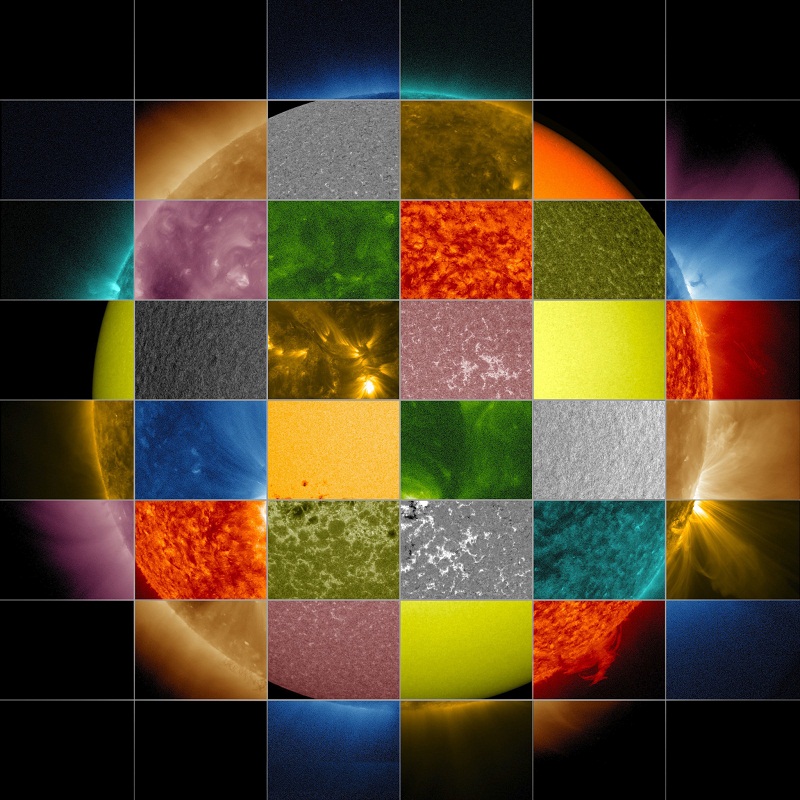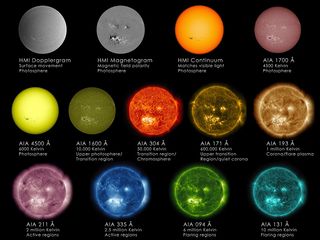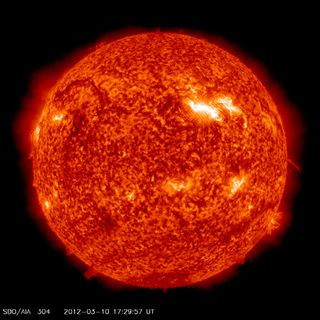The Sun's Different Light: How Scientists Study Our Closest Star

Though the sun appears yellow to the naked eye, it actually emits light in all colors, which scientists can see using specialized telescopes designed to observe wavelengths beyond the visible range.
A more colorful collection of data reveals information about different parts of the constantly changing sun and tells scientists how solar material moves around the sun's atmosphere.
There are two ways that solar telescopes can gather information from the light emitted by the sun. There are spectrometers that can simultaneously observe different wavelengths of light, generating graphs that give a composite picture of the temperature ranges in the material around the sun.
Meanwhile, other instruments can take snapshots of the sun, capturing light in one particular wavelength that might not be visible to the naked eye. For example, the Atmospheric Imaging Assembly (AIA) instrument on NASA's powerful Solar Dynamics Observatory can observe light in 10 different wavelengths — each chosen to highlight a particular part of the sun's atmosphere.
Here's a breakdown from NASA of what can be observed in the wavelengths that SDO captures, measured in Angstroms (one Angstrom equals one ten-billionth of a meter):
- 4500: The sun's surface or photosphere
- 1700: The sun's surface and chromosphere, a layer of the sun's atmosphere just above the photosphere
- 1600: A mixture between the upper photosphere and the transition region, which is between the chromosphere and the outer layer of the sun's atmosphere called the corona
- 304: Light from the chromosphere and the transition region
- 171: The corona when it's quiet, as well as the magnetic arcs known as coronal loops
- 193: A slightly hotter region of the corona and the much hotter material of a solar flare
- 211: Hotter magnetically active regions in the corona
- 335: Also hotter magnetically active regions in the corona
- 94: Regions of the corona during a solar flare
- 131: The hottest material in a flare

NASA's Solar Dynamics Observatory is not the only spacecraft keeping a close eye on the sun. The Solar and Heliospheric Observatory, called SOHO, also monitors the sun under a joint mission by NASA and the European Space Agency. NASA's twin Stereo spacecraft record images of the sun from two vantage points in Earth's orbit (one ahead of the planet and the other behind) in order to generate 3-D views of the sun's weather.
Follow SPACE.com on Twitter @Spacedotcom. We're also on Facebook and Google+.
Get the Space.com Newsletter
Breaking space news, the latest updates on rocket launches, skywatching events and more!

Join our Space Forums to keep talking space on the latest missions, night sky and more! And if you have a news tip, correction or comment, let us know at: community@space.com.

Space.com is the premier source of space exploration, innovation and astronomy news, chronicling (and celebrating) humanity's ongoing expansion across the final frontier. Originally founded in 1999, Space.com is, and always has been, the passion of writers and editors who are space fans and also trained journalists. Our current news team consists of Editor-in-Chief Tariq Malik; Editor Hanneke Weitering, Senior Space Writer Mike Wall; Senior Writer Meghan Bartels; Senior Writer Chelsea Gohd, Senior Writer Tereza Pultarova and Staff Writer Alexander Cox, focusing on e-commerce. Senior Producer Steve Spaleta oversees our space videos, with Diana Whitcroft as our Social Media Editor.









